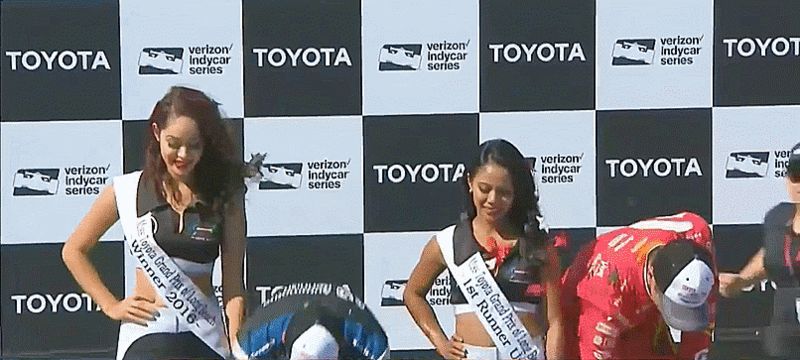
For the second year in a row, the Grand Prix of Long Beach weekend left a driver so angry over a race result that they refused to spray champagne on the podium. This year, it was Scott Dixon, who got royally screwed by IndyCar’s decision not to impose a real penalty for a shortcut made by race winner Simon Pagenaud.
Pagenaud’s right front tire got on the pit-exit line when merging back into race traffic. The rules say that both right-side tires have to stay on the other side of the pit exit line, and Pagenaud’s front right tire clearly didn’t. IndyCar’s response, or rather, non-response was to give Pagenaud a warning.
Advertisement
In any other situation where no advantage was gained, a warning would probably be accepted without much controversy. However, because not penalizing Pagenaud directly affected the result of the race, many believe that Pagenaud should have been forced to give up the position gained somehow.
Sponsored
Compounding the issue is the fact that Long Beach is a street circuit where passes are hard to make even without a shortcut. Dixon tried to get back around Pagenaud himself, but ultimately couldn’t make it happen.
Unsurprisingly, Pagenaud agreed with the series’ response, telling NBC Sports that he didn’t think his minor shortcut really changed all that much:
Going into the race, I know the rulebook, I know you can take risks, the limit. It’s just racing. Quite frankly, another inch to right wouldn’t have changed the outcome of the race.
IndyCar’s race stewards were fairly consistent in their leniency at Long Beach with warnings given for Max Chilton cutting a corner several times at Turn 5 and Carlos Muñoz for cutting across the same pit exit line as Pagenaud. However, neither of those violations directly affected the race result.
Should A Warning Have Even Been An Option?
Some in the paddock understood that warnings would not be given out for violations like this. An article from Racer earlier this year about changes to Race Control, for example, made it sound as if warnings for cut-and-dry violations would be a thing of the past:
Advertisement
In his Friday press conference, [CEO of IndyCar’s parent company Mark] Miles made it clear there would be no more warnings to drivers during an event and an effort to call the penalty on the spot instead of waiting until Tuesday.
Mike Hull, who works as a strategist for Dixon’s Chip Ganassi Racing team, reiterated to NBC Sports that pit lane exit violations meriting an instant penalty even came up in the driver’s meeting for the Grand Prix of Long Beach:
They told us with the steward system they were going to have this year, there would be no warnings, so he was either in the right or the wrong. On the television (replay), it clearly showed all the viewers that (Pagenaud) didn’t stay in a straight line all the way to the exit of the pit lane.
What we were told in the driver’s meeting, if anybody did that, that would be a penalty. They didn’t say what the penalty was, but he shouldn’t be leading the race.
IndyCar’s language in their statement defending the warning makes it pretty clear that the series lumps warnings in with various options for penalties, regardless of the fact that a warning will have no effect on the race itself. Perhaps they need to make a real distinction between a warning (which is widely considered to be a precursor to a substantial penalty, not a penalty in its own right) and a real penalty.
Aftermath
After the race, Dixon seemed to take a page from the Pirelli World Challenge race at Long Beach last year and walked off the podium before the champagne spray.
This was Pagenaud’s first win for Team Penske, first Grand Prix of Long Beach win, and first win since Houston in 2014, which makes it even more awkward. Normally, fans would be celebrating a big win for Pagenaud like this, but many feel as if they can’t under these hotly debated circumstances.
Dixon’s team owner Chip Ganassi had a more measured response to the warning to NBC Sports, arguing that the series should perhaps take a page from NASCAR’s clear-cut enforcement:
It was obviously a questionable call. The video shows one thing and I don’t know what the stewards used to make their decision. But I sort of support what they do. But I kind of like the NASCAR system, where it’s black and white, there’s a camera there and the camera makes the call electronically. Maybe it’s an opportunity for us to improve.
Ganassi has a point: it’s always a bummer to hear that a race result has changed after a race, regardless of whether it’s for an issue with the car or for something that happened during a race.
Any changes IndyCar can make to facilitate the accurate and immediate enforcement of significant rules (such as the ones regarding pit lane exit blend lines) would make it much easier for fans to follow along at home.
[H/T Matt Archuleta for the Racer link]













